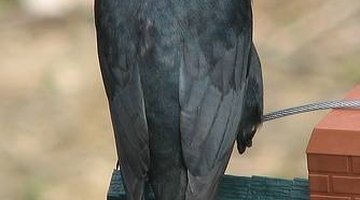How to Get Rid of Cowbirds
The brown headed cow bird is a small blackbird that lays its eggs in the nests of other birds. This often results in the death of hatchlings of the host mother. You need a permit to remove a cowbird egg. You can also deter them by using a small feeder and filling it with food they don't like.

If you don't like bullies, you won't like the brown headed cowbird (Molothrus ater). Reaching a maximum length of about 9 inches, the cowbird is one of the smaller blackbirds. Its appearance is unremarkable; the male has black plumage and a brown head, and the female is plain brown. The cowbird is large and aggressive enough to take over the bird feeder and chase songbirds away, but its bullying habits don't stop there. The cowbird lays its eggs in nests of other, smaller birds and depends on these birds to raise its young. When the young cowbirds have matured, they join their real parents in terrorizing the very birds that raised them.
Cowbird Eggs Are Protected by Law
Cowbird nesting habits bring "intrusive" to a whole new level. The cowbird egg typically hatches one or two days earlier than the others, and the surrogate mother starts feeding the hatchling, which typically grows more quickly and larger than the other birds and demands more food. As a result, some of the smaller hatchlings often die. The young cowbirds receive food from their host for about 39 days. They then fly off. Host birds that don't like this arrangement and remove the cowbird eggs often have their nests destroyed by the larger, parasitic birds.
The Migratory Bird Act of 1918 wasn't passed with cowbirds in mind, but under the Act, they get same same protection as any other migratory species. If you happen across the nest of an eastern bluebird, a yellow warbler or any number of other species and notice a grayish egg with brownish speckles that appears larger than the others, it's probably a cowbird egg. According to law, you can't remove it.
Is There a Legal Way to Stop This?
The Migratory Bird Act does provide some provisions for removing cowbird eggs in some circumstances. One such circumstance is when the host bird is a endangered species. Some states, such as Texas and Michigan, issue permits to trap cowbirds and destroy their eggs to protect such species as Kirtland’s warbler, the golden-cheeked warbler, and the black-capped vireo. It's important to remember that you need a permit before removing cowbird eggs, so ask your local wildlife department how to get one.
Keeping Cowbirds Away
One of the most effective ways to deter cowbirds is to ensure that they have nothing to eat, and you can usually do this without deterring other birds. Use small tube feeders with small perches. Cowbirds are larger than the songbirds you want to encourage to stay and won't be able to use the small feeders. Also, avoid setting out platforms on which the cowbirds can land. Be diligent about keeping bird food off the lawn, because cowbirds typically feed by grazing in the grass.
Fill the feeder with safflower seeds, thistle, whole peanuts or suet. These are all foods that cowbirds won't eat. Avoid sunflower seeds, cracked corn and millet, which are all foods that cowbirds love.
Don't look for nests unless you have a permit. The reason for this is simple: If you find a nest that a cowbird doesn't already know about, and it's watching your movements, you'll lead the bird right to the nest.
References
Writer Bio
Chris Deziel has a bachelor's degree in physics and a master's degree in humanities. Besides having an abiding interest in popular science, Deziel has been active in the building and home design trades since 1975. As a landscape builder, he helped establish two gardening companies.
Photo Credits
- Itshears http://www.flickr.com/photos/19598613@N00/457956859/
- Itshears http://www.flickr.com/photos/19598613@N00/457956859/
More Articles



